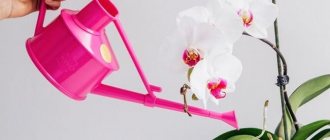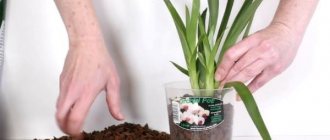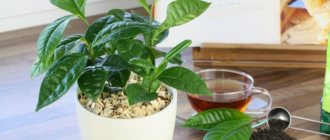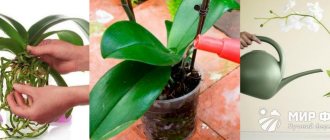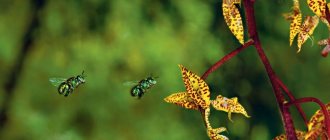Orchid is one of the most popular house plants . It has earned popularity due to its unpretentiousness and beauty.
Below is information about watering, because good and proper watering of orchids will allow you to see them bloom.
The orchid
has been famous for a long time :
- For more than 3000 years it has already been known, popular and loved;
- Medicines and love potions from it It is still used in medicine today;
- The nutritional value of some species is also known. I’ll just name vanilla;
Orchids grow in many countries. - For centuries, an orchid has been one of the best and most expensive gifts;
- Under natural conditions it grows on all continents. Except Antarctica . In the tropical zones of Southeast Asia, South and Central America, and the northern part of Australia, they grow most naturally;
- And it has gained well-deserved popularity these days. There is an opinion that in our country this is only the beginning of its popularity.
Let's find out in more detail below whether it is possible to water an orchid with ordinary water and what different watering methods exist.
General provisions for plant moisture
Is it possible to water an orchid from above? For many gardeners, the question of how to water correctly is similar to the question of how many times to water . Every day. In one day. 2 times per week. Under natural conditions, the regulation of watering does not depend on the plant. It rains often and a lot.
What can you offer to a representative of the tropics in an apartment or private house? Only after becoming familiar with the characteristics and advantages of your pets will you plan your actions.
So take into account some of their nuances :
- Orchids such as Miltonia, Paphiopedilium, Phalaenopsis, Cymbidium prefer soil mixtures when wet. Before watering. And do not allow the substrate to dry out;
- A whole group of orchids feels more comfortable if the soil dries out completely. Let it be for a while. But they must remain without moisture. And immediately there is an increased interest in these types of individual gardeners. Even if you missed it a little, it turns out it’s not scary, but even useful. These species are : Odontoglossum;
- Dendrobium;
- Cattleya;
- Oncidium (and its hybrids).
- Temperature;
- The approach must be individual. But the main criterion is soil condition. So experts give recommendations for all orchids with a gap. In summer - from 1 to 3 times a week. During the rest period - 2-3 times a month;
When watering orchids, you need to take into account their characteristics.
- Spraying the roots;
Orchids can be watered in the evening.
Attention! Experts give preference to morning watering. By evening the plants dry out. Not everyone has time in the morning. And you can water it in the evening. If there is a small temperature difference.
Some tips
- Do not take hot showers at high or low temperatures indoors or in areas with poor ventilation. In this case, humidity increases, which provokes the growth of bacteria, mold and fungal diseases.
- If you do not wipe the growing point of the orchid after a shower, this will provoke the appearance of wet rot. Most other plants do not have this problem.
- If there is rot in any part of the orchid, showering is contraindicated for it.
Here are all the advantages and disadvantages of a hot shower for an orchid.
Found a violation? Report content
Watering methods
It is quite difficult to arrange tropical rain in an apartment or even a greenhouse . Knowing the types of orchids you have will help you choose the most appropriate watering option. And the features of caring for them.
Advice! You can alternate watering methods (immersion, watering from a watering can).
Dive
- This method allows you to saturate all parts of the root system with moisture. Provides access to all its parts: Be selective about the time the plant is in water;
- Containers of different sizes;
- Young plants;
- Different stages of orchid development.
- Prepared water is poured into the basin. You can also add fertilizers to its composition (if it’s time to feed);
watering with this method with smaller containers . So that they can add water to large pots.
From above from a watering can
Is it necessary to water an orchid from above using a watering can? This method is used quite often :
- Place the flower pot on the grill. In the bathtub or basin;
- prepared warm water over the edges of the container . Small doses and a weak stream. Until you see water pouring out of the bottom holes of the pot;
- The water is drained from the pan;
- Careless watering can lead to moisture getting on the leaves and in their axils. They all need to be carefully removed with a napkin. And dry the plant;
- Depending on the condition of the soil, a repeated procedure . In 40-45 minutes. The roots do not always have time to absorb moisture.
Hot shower
Some gardeners use hot water irrigation:
- A warm shower is not needed. And warm (40-50 degrees) and soft water is needed. It creates the feeling of tropical rain. Stimulates the growth of foliage and subsequent flowering : Place containers with orchids in the bathroom;
- This should be done through a sprayer (shower head) and low water pressure;
- Determine the duration of watering based on the condition of the substrate. Half a minute is enough even for large containers;
- They should stand for about 15 minutes to allow the water to drain;
- If the soil is not saturated in one go, repeat the shower for the plant.
Attention! You can also use a watering can with a spray nozzle to organize your shower. If tap water is not trustworthy. Avoid hot showers in winter. The temperature difference is too great.
Spraying the roots
- Spraying of the roots is carried out on hot days . It's more comfortable for the plants in the morning. Some species require this to be done 2-3 times a day;
- It is simply necessary for plants placed without soil on blocks and in baskets. Their roots dry much faster on such structures than in pots;
- It suits Vandams very well. Their long and thick roots seem to be specially created for such watering . And it’s not very convenient to remove such huge plants for other methods;
- In winter, at low temperatures, this method is used very carefully ;
- For spraying, choose a good spray bottle. So that the dispersion is of high quality. In the form of fog. This should not be done from close range.
Important! Do not spray after fertilizing.
Through the pallet
- This method is used to water many types of flowers. The plant receives moisture from the roots located below;
- The main question. What kind of tray does your orchid have? Many gardeners install transparent containers in pots with a raised bottom in the middle. There is somewhere for excess moisture to drain. Their evaporation until the next watering maintains a humidified climate. Excess can be drained;
- It must be taken into account that the upper roots cannot always receive such moisture;
- As a type of such irrigation. Use a more intensive option . Spilling water. From a watering can or tap. Its purpose is to remove fine salts and dead particles with running water;
- Do not water the flowers. They may fall off;
- Place the plant on grates to allow excess moisture to drain out . For 30 minutes;
- Wipe the leaves and stems with a napkin. Take special care to remove moisture from the leaf axils.
How not to water orchids
Some people often overwater epiphytic plants, which leads to their death. Let's look at a few common mistakes that should not be made:
- watering with hard and cold water helps to lighten the foliage with its subsequent death and death of the roots;
- the accumulation of drops of water in the axils of the leaves causes the plants to rot - first the root collar rots, the leaves die, then the roots;
- when spraying, water should not be allowed to get on the base of the phalaenopsis;
- spraying should be carried out in the morning, otherwise burns of the foliage cannot be avoided;
- if there are several diseased specimens in the collection, it is forbidden to use immersion watering, otherwise healthy orchids will also get sick;
- cannot be grown without a drainage layer, it is this that will help preserve the root system and prevent it from rotting;
- With infrequent watering, the leaves fall off, the roots dry out, and the plant dies.
Frequent watering is not recommended. If the roots are constantly splashing in water, they will definitely begin to rot.
Drainage
To prevent watering from harming the flower, special attention should be paid to the drainage for the orchid, which must be in every orchid pot . Holes are made not only in the bottom, but also along all the walls, this will facilitate the drainage of excess water and ensure normal ventilation of the substrate.
For phalaenopsis orchids that are grown in baskets, you don’t have to think about drainage. This weaving will allow air masses to circulate normally, and excess water will come out without effort.
Reanimation
Photo by Ekaterina Masik
Most often, you have to save recently purchased flowers. I put them on a shelf where the light is lower and pay special attention to them. In each case, resuscitation actions are different. I'll tell you how I try to save adult flowers whose roots have died.
Let me make a reservation right away: a plant cannot be restored from a leaf. But if the neck is at least partially preserved, then you can try. The neck is stripped down to healthy tissue and dipped in cinnamon. The flower is inserted into the cut neck of a plastic bottle, and the neck is inserted into the bottom of the water bottle. In this case, the plant should not touch the water (see photo). If you notice that the cut is getting wet, dip it in cinnamon again. Thus, you need to grow 5-7 cm of roots, and after that the flower can be transplanted into the ground. I managed to save several flowers, and you should too.
General rules
In order not to harm the phalaenopsis orchid and fully satisfy its need for moisture, you should follow these simple rules:
- watering is carried out only with soft water;
- before watering, it is advisable to further enrich the water with oxygen;
- the water temperature should be no lower than room temperature;
- The phalaenopsis orchid needs watering at different times of the year at different intervals, usually determined by the color of the roots and the presence of condensation on the walls of the pot.
Watering is the most important part of caring for orchids.
With watering, the flower also receives fertilizing ; it is applied only every other time in the spring-summer period.
Which types of flowers respond well to a hot shower and which don't?
The following plants tolerate hot showers well:
- Spathifulluma
- Guzmania
- dracaenas
- diffebachia
- ivies
- indoor ferns
- myrtle
- noble laurel
- chamedorea
- Scheffler
- indoor roses
- Phelaenopsis
- hibiscus
- ficus
- azaleas
- anthurium
- arrowroot
The procedure can be performed on some cacti and succulents.
You should not treat plants such as:
- violets
- gloxinia



